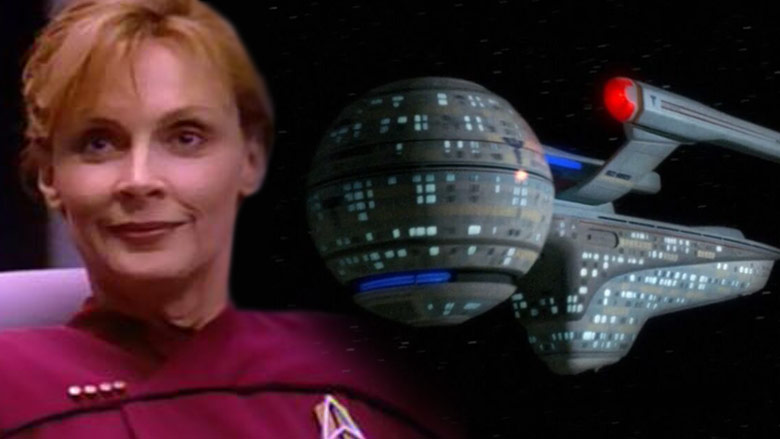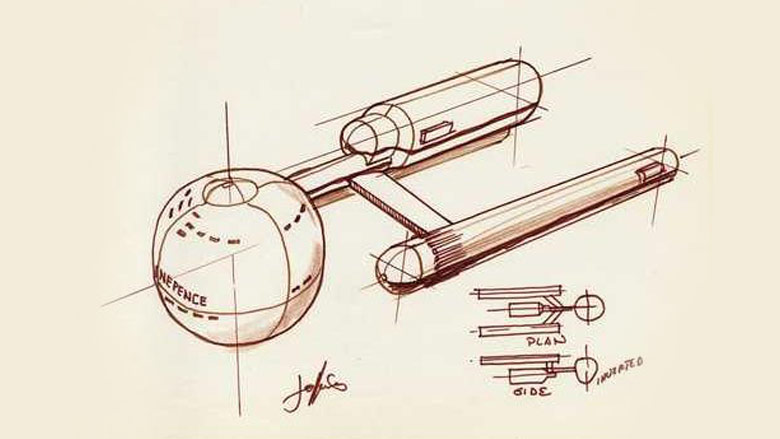
Screengrabs from CBS Captain Beverly Picard and the U.S.S. Pasteur.
The design of the space-faring vessels in science fiction films and movies ensures difference. For the most part, each show has a distinct style that is easily recognizable to both hardcore fans and the lay audience.
The ships created for “Star Wars” are famous for eschewing the aerodynamic look of what NASA and other space agencies have in real life. This is, of course, because there is no atmosphere in space, so there’s no need for streamlined shapes — unless you count the Naboo Royal Spaceship from “The Phantom Menace.” But the original designs by Ralph McQuarrie from the 1970s mostly kept to the jagged and non-aerodynamic appearance.
The ships in the “Alien” have arguably a more realistic look, as created by designer Syd Mead. Same goes for the vessels built for the 1970s show “Space: 1999.” The modular design of the Eagle and Hawk ships look as if they might really be in development at Space X or Lockheed.
The ships of “Star Trek” are different. As fans across the world can recognize a ship from the Trek Universe in an instant. The iconic saucer section, secondary hull design, and nacelles are part of Trek as a phaser or transporter. Dreamed up originally by Matt Jefferies, the look for the original Starship Enterprise took on many shapes before settling on the one we all recognize today.
His design is so famous that the original Enterprise model from the series is part of the Smithsonian’s National Air and Space Museum in Washington, D.C.
As he pitched the various designs to Trek creator Gene Roddenberry, Jefferies came up with several concepts. The one that Roddenberry chose back in 1964 retained the look for what fans know today but was called the “Yorktown.” The ship would undergo a name change. From there, Roddenberry created a list of “commandments” or design rules for the vessels operating in the Trek Universe.
Roddenberry’s Rules for Ship Design
When it came time for “The Next Generation,” designer Andrew Probert was charged first with creating the bridge’s look and then the exterior of the Enterprise-D. Probert stuck with those design rules, which included:
Rule #1 – Warp nacelles must be in pairs.
Rule #2 – Warp nacelles must have at least 50% line-of-sight on each other across the hull
Rule #3 – Both warp nacelles must be fully visible from the front
Rule #4 – The bridge must be located at the top center of the primary hull
In an August 2020 interview with Trek Report, Probert shared what it was like to work for “The Great Bird of the Galaxy” — the nickname Roddenberry was given by those in his orbit.
“I respected him beyond anyone else,” Probert said in the interview. “I was gob-smacked [to be working with Roddenberry].”
Probert created the new Enterprise for TNG, as well as the new Romulan Warbird and the Ferengi Marauder. After he set the design for the series with these new ship designs, Probert departed to work on other projects like “Streethawk” and “Indiana Jones and the Temple of Doom.”
The End of ‘The Next Generation’
Seven years later, when it was finally time to end the adventures of Jean-Luc Picard and his crew, Brannon Braga and Ronald D. Moore created the masterpiece two-part episode “All Good Things….” This finale would see Captain Picard jump into three separate timelines to save humanity from the judgment of Q (John de Lancie).
In a future timeline, Picard (Patrick Stewart) is no longer a part of Starfleet but must beg for help from Admiral William T. Riker (Jonathan Frakes), who is now in command of the Enterprise-D. The ship is now equipped with a third nacelle (breaking Roddenberry’s first starship design rule) and advanced weapons.
Picard is able to enlist the help of comrade Captain Beverly Picard (Gates McFadden), who is in command of the U.S.S. Pasteur. Her ship is a medical vessel and features not a saucer section but a rounded orb in its place.
Why the U.S.S. Pasteur Needed to Be Different
Designer Bill George, who also worked on five “Star Trek” films for Industrial Light and Magic, created the Pasteur for the episode. He appeared in January 2021 on the “Inglorious Treksperts” podcast. He shared why he chose a spherical design rather than the usual saucer shape.
George said that he had a conversation with Michael Okuda, who told him that the crew was unhappy that some “average viewers” could not tell the difference between the various Federation ships.
“I harkened back to the ‘Making of Star Trek’ book that came out in the late ’60s that had all these amazing drawings of the Enterprise evolution before they picked the final design,” said George on the episode.
“One of them had a spherical primary hull,” said George. “And then I thought, ‘What if that followed the same design arc as the Enterprise?’”

Forgotten TrekSpherical Ship Design from Matt Jefferies
George then got more technical information from Okuda on how the ships on TNG were rigged up and filmed. He designed and built the model, which turned out to be about 3-feet long. He sent Okuda photos of the finished model, and Okuda asked if the show could rent the Pasteur.
“It was originally called the Olympic,” George told the Treksperts. “I was originally working on ‘Ghostbusters II’ at the time, and we were doing a lot of research on the Titanic because he had built a miniature Titanic that had come back to New York.”
The Pasteur certainly stands out among Federation ships. Replaced was the usual ‘frisbee’ shape with a round ‘basketball’ orb for the primary hull. There are several fan theories on this difference, but luckily, thanks to Bill George, fans know the actual motivation.
George learned that the Titanic’s sister ship was named the Olympic, which later became the ship’s classification. The show rented the model from George and returned it after the episode was completed.
“I got to keep the model, and that was rare,” George said.
READ NEXT: How One of the Worst ‘Star Trek’ Films Became Its Most Significant